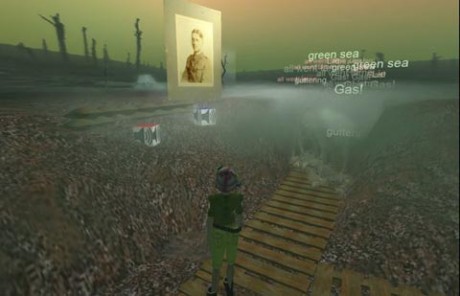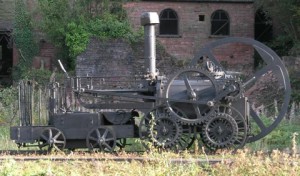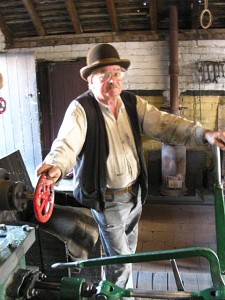Posts from — October 2009
“…And each slow dusk a drawing down of blinds.”
As readers may know, one of my several activities is audio production, both voice-over work and the production of complete packages with voice, music, effects and so on.
Recently many of these productions have been particularly associated with educational programmes, clients including the British Library and City of Sunderland College. Interestingly, all these projects have resulted from meeting people in the virtual world of Second Life. (Partially as a result, incidentally, I do not have a great deal of time for people who criticise me for “playing” in SL or try to convince me that nothing significant will come of it.)
I have a teaching qualification myself, and I’m particularly interested in the educational possibilities of virtual worlds: Second Life is by far the most popular and widely-used of the virtual worlds currently available, although there is increasing activity in “OpenSim” variants using essentially the same technology.
Most recently I was introduced to some of the staff of the First World War Poetry Digital Archive, based at the University of Oxford. They are on the point of launching (on 2 November) a new region in Second Life (named Frideswide after the patron saint of Oxford) which is home to a painstakingly-built environment designed to shed light on aspects of the life of soldiers in the trenches along the Western Front during the First World War. Students can visit the site and learn not only about the conditions endured by infantrymen during the Great War but also hear poetry from the ‘War Poets’, along with interviews and tutorials.
Here’s how they describe the installation:
This tour of a stylised version of the trench systems in the Western Front has … two objectives:
• to show you the physical context of the trench systems
• to expose items held in the First World War Poetry Digital Archive in a three-dimensional environment…This [is] not an attempt to give you a realistic experience of what it was like to be on the Western Front. The physical depravation, or the chance of serious injury or death, cannot be replicated, and this should always be remembered.
More importantly perhaps, this is but one view of the War – and it would be safe to say this is a view open to discussion. …we have presented rain-sodden trenches, infested by rats, in gloomy surroundings. But this was not always the case. The opening day of the Battle of the Somme, for example, was a beautiful summer’s morning in stark contrast to the depictions we often see of the muddy hell of Paaschendaele.
Chris Stephens, who has been instrumental in putting the simulation together, commissioned me initially to provide an audio version of an A‑level/University-level Tutorial on “Remembrance” along with four poems: Anthem for Doomed Youth by Wilfred Owen, Does It Matter? by Siegfried Sassoon, plus Louse Hunting and Dead Man’s Dump by Isaac Rosenberg.
I’ve now recorded some additional poetry readings – Repression of War Experience, Aftermath, and On Passing the New Menin Gate, all by Siegfried Sassoon; plus 1916 Seen From 1921 and Can You Remember by Edmund Blunden – and an introduction and epilogue.
These poems have a great deal to tell us about the feelings of their authors, and many of them are powerfully moving. Dead Man’s Dump in particular is full of vivid, detailed imagery.
The tutorial, on the other hand, encourages us to ask a number of questions about our conception of what the Great War was like, and uncovers where much of our information has come from. It also challenges some of our assumptions about the conflict. At the time of writing, there are only three veterans of the First World War left alive, so we rely increasingly on indirect sources.
In the Second Life representation, you start off at an army camp and then proceed to the trenches via a floating bubble, during which you hear the introduction to the installation.
Once at ground level in the trenches, you can walk around and visit different aspects of the trench network. Along the way, images of soldiers flicker into view and you might hear an interview or a piece of poetry. The tutorials are accessed via a “HUD” (Head-Up Display) enabling you to proceed through the material and exercises at your own pace. Additional audio extracts are initiated by clicking on loudspeaker symbols.

A scene from the University of Oxford’s First World War representation in Second Life. The visitor is able to walk around in the trenches and ultimately climb a ladder up on to the battlefield itself; the cubes with a loudspeaker symbol on them enable playback of audio material such as poetry readings and interviews. The green-tinged cloud and floating text ahead are part of a section on the use of poison gas during the War.
Overall, the Second Life representation is quite an intense and powerful experience, and I can imagine it will be a particularly effective educational tool.
The challenge for an environment like this is that there is a fairly steep learning curve before visitors can fully experience what a virtual world like Second Life can offer – before you can experience an installation like this you have to learn how to move around, activate things and generally operate successfully in the environment. However in this case you really need to be able to do little more than walk around and click on objects, so most people will require no more than a few minutes of training to be able to get the most out of virtual re-creations like this.
I wish the First World War Poetry Digital Archive every success with this project and am very pleased to have been able to make a small contribution to it. This installation will also be featured in the 10 November edition of the Designing Worlds show on Treet.TV.
*“…And each slow dusk a drawing down of blinds.” is the final line of Anthem for Doomed Youth by World War I poet Wilfred Owen – one of the WWI poems I’ve recorded for this project. Photos courtesy of First World War Poetry Digital Archive.
October 26, 2009 Comments Off on “…And each slow dusk a drawing down of blinds.”
Ironbridge Gorge Museums
Ironbridge, near Telford in Shropshire, is rightly regarded as one of the foundations of the Industrial Revolution. Here in 1707, Abraham Darby perfected (and patented) a method of smelting iron ore using coke.
Previously, the process required charcoal, which takes a great deal of time and effort to produce, first growing the trees (!), then burning the wood under the right conditions. As a result, the amount of iron that could be smelted was limited by the supply of charcoal. The discovery of a means of using coke – which is derived from coal – meant that iron could be produced as quickly as the coal could be mined. This enabled the Industrial Revolution to take off.
In 1779 the great Iron Bridge across the Severn, after which the town is named, was built by Abraham Darby III. It was the first cast-iron bridge in the world.
Today, the industry that characterised the area for hundreds of years is largely silent, but in its place is a collection of nearly a dozen different museums and attractions that help us to understand our industrial heritage. You can find out more about them here. In 1986 the Gorge was one of the first seven UK sites awarded World Heritage Site status by UNESCO.

The Museum of the Gorge is housed in a converted Gothic-style riverside warehouse, where goods where stored prior to shipping down the Severn.
To see all the major locations will take you more than a day, particularly as a result of the extensiveness of Blists Hill Victorian Town. However, I suggest you start at the Museum of the Gorge, which boasts one of the most detailed dioramas I’ve ever seen, in this case of the stretch of the Severn and the enormous collection of industrial activities carried out here from mediæval times onwards.
In addition, you might like to take in the Coalbrookdale Museum of Iron. However the most extensive location to visit in the area is Blists Hill Victorian Town. Based around the site of an old brick works, the town consists of buildings either restored, relocated or specially built following detailed research.
You enter the town via a very impressive (and recent) audiovisual presentation which highlights the region’s industrial heritage, and then you’re on the main street, where the first building is a Lloyds Bank. Here you can exchange modern money for traditional pre-1971 £.s.d. that you can use to buy items in the shops on the site (they also take modern money, unlike the Kentwell Hall’s Tudor re-enactments, where beyond the “time tunnel”, all transactions have to be done with the traditional coinage).

Replica of Richard Trevithick’s locally-built Pen-y-Darren locomotive of 1809
There are working steam engines, including one used to raise and lower a mine cage and a replica of Richard Trevithick’s 1802 Pen-y-Darren locomotive. There are a couple of very impressive beam engines originally used to blow air into blast furnaces, but regrettably these will never steam again and are demonstrated by driving with an electric motor.

The operator of the mineshaft winding gear steam engine
Costumed staff are on hand to describe the businesses, shops and industry of the Victorian era and I was very tempted to turn up in costume – though I was not sure how they would react. Some places love you to do that, while others (notably Kentwell) abhor it, as you might be mistaken for staff and, not knowing the back-story, might let them down (at Kentwell the back-story is so detailed that this is a real possibility). Beamish, I seem to recall, lets you turn up in costume and they give you a special tag (suitably printed in letterpress fonts of the period, presumably in their print shop) to indicate that you’re a “Visitor”.
Indeed, the obvious comparison with Blists Hill is Beamish, and there is apparently a little rivalry between the two sites, it was hinted, but in fact the two, while there is some obvious overlap, have some significant differences – the money at Blists Hill and the trams at Beamish for example. At Blists Hill, you get around on foot or by horse-drawn wagon.
Blists Hill has a wide selection of shops, sometimes producing and selling items; there are also some performances by a pair of actors who present hilarious excerpts from Shakespeare (with the help of the audience) and there are music-hall songs in the pub from time to time.
I did not take a great deal of video, but here is one extract. Down the bottom of the town there’s a Victorian funfair, including a merry-go-round, which originally, one presumes, would have been driven by a steam traction engine. There’s a nice little Pell organ on this one, playing various medleys of tunes of the era, of which you can hear a sample below.
October 1, 2009 Comments Off on Ironbridge Gorge Museums


